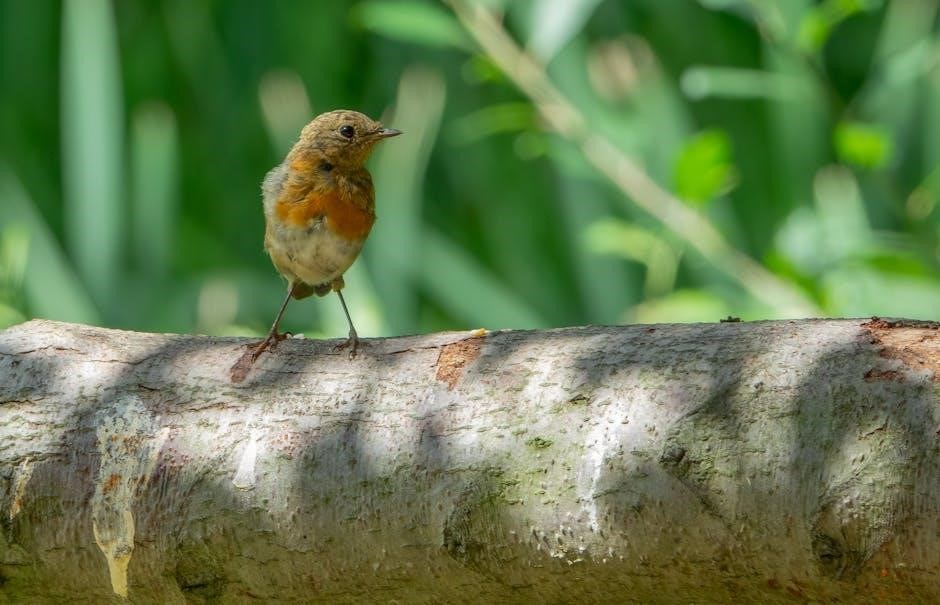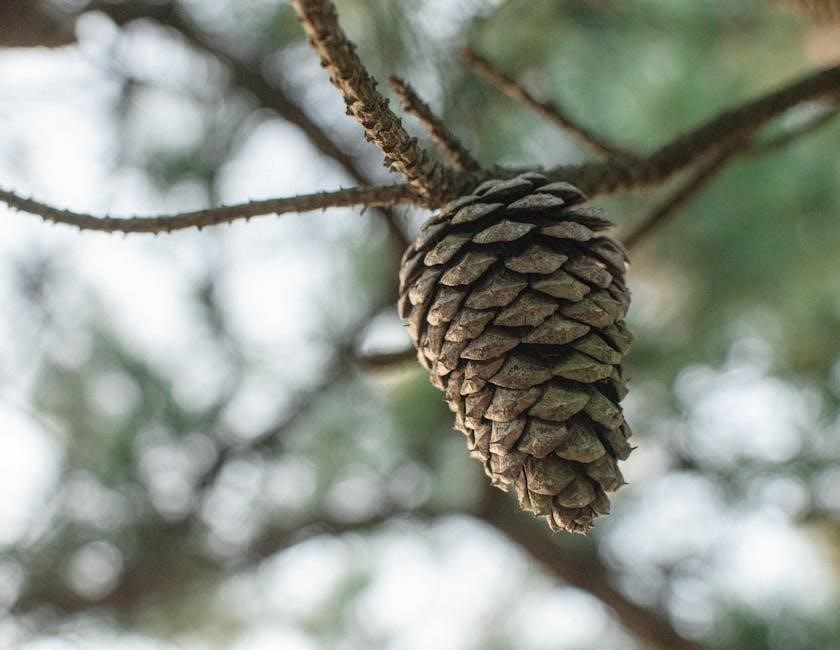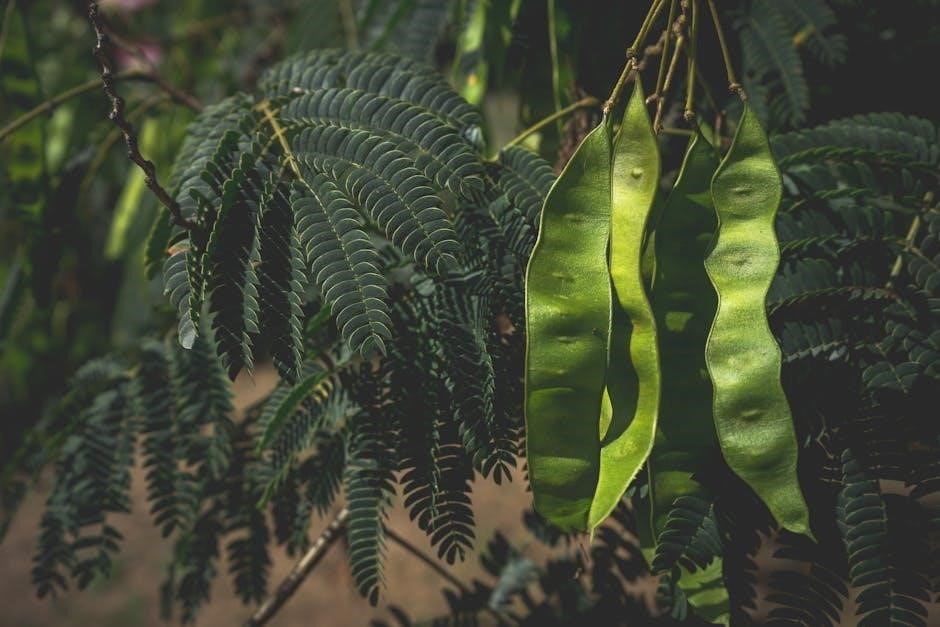Tree seed pods are structures holding seeds, varying in shape, size, texture, and seed release mechanisms. They aid in tree identification, especially when leaves are absent. This guide helps readers recognize and classify seed pods, enhancing tree identification accuracy.
1.1 What Are Tree Seed Pods?
Tree seed pods are structures that contain seeds, essential for a tree’s reproduction. They develop after flowering and protect seeds until they’re ready to disperse. Seed pods vary widely in shape, size, texture, and seed release mechanisms. Some common forms include legumes, capsules, catkins, and cones. Not all trees produce seed pods; for example, pines produce cones instead. Seed pods are crucial for tree identification since they often have unique features that distinguish one species from another. Understanding these structures can aid in accurately identifying tree species, especially when leaves are absent.
1.2 Importance of Seed Pods in Tree Identification
Seed pods are vital for tree identification, offering unique characteristics that distinguish species. They often remain on trees longer than leaves, making them a reliable feature for identification, especially in autumn and winter. Seed pods complement leaf identification by providing additional traits like shape, texture, and seed release mechanisms. Their distinctive features help differentiate species, even when leaves are absent. Accurate identification of seed pods enhances understanding of tree diversity and supports ecological and botanical studies. They are a key element in field guides and online resources, aiding both experts and enthusiasts in identifying tree species effectively.

Key Characteristics for Identifying Tree Seed Pods
Tree seed pods vary in shape, size, texture, and seed release mechanisms. These characteristics help distinguish species. Not all trees produce pods, making them unique identifiers.
2.1 Shape and Size of Seed Pods
Seed pods come in diverse shapes and sizes, ranging from elongated legumes to spherical capsules. Legume-type pods are long and narrow, often containing multiple seeds, while capsule-type pods are shorter and split open to release seeds. Catkin-type seed pods are cylindrical and soft, often found in clusters. Cone-type pods, common in conifers, are rigid and woody, varying greatly in size. Observing these structural variations helps in distinguishing species. Shape and size are among the first characteristics to note when identifying seed pods, as they provide immediate clues about the tree’s classification and seed dispersal methods.
2.2 Texture and Color of Seed Pods
Texture and color are critical for seed pod identification. Pods can be smooth, hairy, or woody, with colors ranging from green to brown, grey, or even vibrant hues. Some pods, like legumes, may have a papery texture, while others, such as capsules, are often rigid or leathery. Color changes during maturation, with many pods turning from green to brown or black. These traits, along with shape and size, provide essential clues for distinguishing species. Texture and color variations also reflect adaptations for seed dispersal, making them vital for accurate identification.
2.3 Seed Release Mechanisms
Seed release mechanisms are crucial for identifying tree seed pods. Some pods burst open explosively, scattering seeds, while others split gradually or remain intact, releasing seeds through small openings. The timing and method of seed release are adapted to environmental conditions, ensuring effective dispersal. For example, explosive pods quickly spread seeds away from the parent tree, while slower releases may rely on wind or animal assistance. Observing these mechanisms provides insights into a tree’s reproductive strategies and helps distinguish between species.
Common Types of Tree Seed Pods
Tree seed pods vary in types such as legume, capsule, catkin, and cone, each with distinct shapes and seed release methods, aiding in species identification, commonly seen in Fremont trees.

3.1 Legume-Type Seed Pods
Legume-type seed pods, like those of Fremont cottonwood, are elongated and split open to release seeds. They are typically hairy, with multiple chambers containing small, brown bean-like seeds, aiding identification. These pods are common in plants like Abutilon vitifolium, where they form slightly hairy balls with eight chambers. Their distinctive structure and seed release mechanism make them a key feature in tree identification, particularly during autumn when they are most visible and seeds are dispersed effectively for propagation.
3.2 Capsule-Type Seed Pods
Capsule-type seed pods are dry, seed-bearing structures that split open to release seeds. They are often found in trees like cottonwood and willow. These pods typically have multiple chambers and vary in texture, from smooth to hairy. Unlike legumes, capsules do not split along two seams. They are an essential feature for identifying certain tree species, as their shape, size, and seed release mechanisms are unique. Observing these details helps distinguish between similar species, making capsules a valuable tool in tree identification, especially during autumn when they are most prominent and seeds are dispersed. Their structure aids in propagation, ensuring seeds reach new environments effectively.
3.3 Catkin-Type Seed Pods
Catkin-type seed pods are elongated, drooping structures resembling catkins, common in trees like birch and alder. They are actually clusters of small, petalless flowers that develop into seed-bearing pods. These structures are usually cylindrical and can be quite long, releasing numerous tiny seeds. Unlike other pods, catkins often dangle from branches, making them highly visible. Their unique shape and hanging nature make them a distinctive feature for identification. The seeds they contain are typically small and wind-dispersed, aiding in widespread propagation. Recognizing catkins helps in identifying specific tree species, particularly during spring and early summer when they are most prominent. Their appearance and function are crucial for accurate tree classification and understanding seed dispersal strategies.
3.4 Cone-Type Seed Pods
Cone-type seed pods are most commonly associated with coniferous trees like pine, spruce, and fir. These pods, often referred to as cones, are hard, woody structures that protect seeds until they are ready to disperse. Cones vary in size and shape, with some being small and cylindrical while others are large and oval. They are composed of scales that open to release seeds, often with a wing to aid wind dispersal. Cones are a key feature for identifying evergreen trees, as their size, texture, and seed arrangement are unique to specific species. They are a vital part of the tree’s reproductive cycle, providing a protective environment for seed development. Observing the structure and details of cones can greatly enhance the accuracy of tree identification, making them a valuable tool for naturalists and botanists. Their distinctive appearance and functional design set them apart from other seed pod types, offering clear clues for classification. Understanding cone characteristics is essential for effectively identifying coniferous tree species and appreciating their ecological role. By studying cones, one can gain insights into the diversity and adaptability of these remarkable seed-bearing structures. Cones are not only functional but also visually striking, adding to the beauty of the trees they belong to. Their unique features make them a fascinating subject for study and observation in the field of botany and tree identification. Cones are truly one of nature’s most efficient and elegant seed dispersal mechanisms, ensuring the survival and propagation of countless tree species. Their significance cannot be overstated, as they play a critical role in maintaining the balance of ecosystems worldwide. Cones are a testament to the ingenuity of natural design, offering both protection and mobility to the seeds they carry. In summary, cone-type seed pods are indispensable for accurate tree identification and understanding the life cycles of coniferous plants.

Step-by-Step Guide to Identifying Seed Pods
- Observe the seed pod’s structure, noting shape, size, and texture.
- Document features like color, seed release mechanisms, and unique markings.
- Use field guides or online resources to compare and confirm identification.
4.1 Observing Seed Pod Structure
Start by carefully examining the seed pod’s shape, size, and texture. Note whether it is elongated, spherical, or irregular. Observe how seeds are arranged inside—whether in chambers, embedded in pulp, or loosely packed. Check if the pod splits open, releases seeds explosively, or remains intact. Look for unique features like hairs, spines, or ridges. Compare these observations with reference images or field guides to narrow down possibilities. Pay attention to any distinctive patterns or colors that could aid identification. This detailed examination lays the foundation for accurate classification and species recognition.
4.2 Documenting Seed Pod Features
Accurately documenting seed pod features is crucial for precise identification. Take clear photographs or make detailed sketches, noting size, shape, color, and texture. Record whether the pod splits open or remains closed, and how seeds are arranged inside. Measure length and width using a ruler or calipers. Note any unique patterns, such as ridges, hairs, or spines. Document the number of seeds and their appearance, including color and shape. Use a field guide or digital app to compare findings. Label and store samples carefully for future reference. This systematic approach ensures comprehensive data for accurate identification.
4.3 Using Field Guides and Online Resources
Field guides and online resources are invaluable for seed pod identification. Utilize detailed descriptions, high-quality images, and comparison charts to match observed features. Websites like iStock offer royalty-free images for visual reference. Apps such as Leafsnap or PlantSnap provide instant species identification. Online databases, like the Seed ID Guide, offer expanded galleries and fact sheets. Cross-reference findings with multiple sources to ensure accuracy. Updated tools often include new species and improved search functions. These resources enhance identification efficiency and accuracy, making them essential for both beginners and experienced botanists. Regularly consult these aids to refine your identification skills over time.
Visual Identification Tips
Compare seed pods with reference images to identify unique features. Use high-quality visuals from resources like iStock to aid in accurate identification and classification of species efficiently.
5.1 Comparing Seed Pods with Reference Images
Using high-quality reference images is crucial for accurate seed pod identification. Compare shape, size, texture, and color with reliable sources like iStock or field guides. Observe unique features, such as serrations or chamber counts, to distinguish species. For example, the Abutilon vitifolium seed pod is a hairy ball with 8 chambers. Documenting these details helps match seed pods to their tree species effectively. Updated guides, like the Seed ID Guide, offer expanded galleries and fact sheets for precise comparisons, ensuring accurate and efficient identification of even the most similar seed pods.
5.2 Noting Unique Features for Accurate ID
Noting unique features like shape, size, texture, and seed arrangement is essential for accurate seed pod identification. For instance, Fremont cottonwood seed pods differ in leaf serrations and flower structure. Documenting details such as chamber counts or seed colors helps distinguish species. Labeling collected seeds with species names and collection locations ensures clarity. Using resources like the Seed ID Guide, with its expanded galleries and fact sheets, enhances accuracy. Paying attention to these distinctive traits minimizes misidentification and improves your skills in recognizing seed pods effectively.

Common Mistakes in Seed Pod Identification
Common mistakes include misidentifying similar seed pods and overlooking key characteristics. Carefully observing and documenting features ensures accurate identification, avoiding errors.
6.1 Misidentifying Similar Seed Pods
Misidentifying similar seed pods is a common error, as some species share nearly identical characteristics. For instance, the Fremont cottonwood and eastern cottonwood have seed pods that are easily confused due to their comparable structure and release mechanisms. Without close examination, distinguishing between them can be challenging. Additionally, seed pods like those from flowering maples and similar species may look alike, leading to incorrect classifications. To avoid such mistakes, it’s crucial to meticulously observe details like texture, size, and seed arrangement. Using reference images and field guides can also help mitigate these identification errors effectively.
6;2 Overlooking Key Characteristics
Overlooking key characteristics is another common pitfall in seed pod identification. Rushing observations often leads to missed details, such as subtle texture differences or unique seed release mechanisms. For example, legume pods and capsule pods may appear similar, but their seed dispersal methods vary significantly. Neglecting to note these distinctions can result in misidentification. It’s essential to thoroughly document features like shape, size, and seed arrangement. By slowing down and focusing on these details, you can avoid errors and improve accuracy in identifying tree seed pods effectively. Proper documentation and comparison with reliable field guides are also crucial for success.
Mastering tree seed pod identification requires patience, attention to detail, and practice. By understanding key characteristics, you’ll enhance your ability to recognize species accurately. For further learning, explore field guides, online databases, and botanical resources to deepen your knowledge and refine your skills in tree seed pod identification.
7.1 Summarizing Key Takeaways
The identification of tree seed pods relies on observing their shape, size, texture, and seed release mechanisms. Documenting these features and comparing them to reference materials is essential for accurate identification. Understanding the unique characteristics of seed pods, such as their structure and how they disperse seeds, enhances your ability to distinguish between species. Using field guides, online resources, and visual aids can significantly improve your skills. Remember, practice and patience are key to mastering seed pod identification, as it is a valuable tool for understanding and appreciating the diversity of tree species.
7.2 Recommended Tools for Advanced Identification
For advanced seed pod identification, utilize field guides, online databases, and mobile apps like Leafsnap or PlantSnap. High-quality magnifying tools and binoculars can provide detailed observations. Refer to seed identification charts and botanical keys for precise classification. Websites like iNaturalist and expert forums offer community support for challenging cases. Additionally, consult updated botanical journals and seed atlases for in-depth information. These resources collectively enhance your ability to accurately identify seed pods and expand your knowledge of tree species. Leveraging these tools ensures a comprehensive approach to seed pod identification.


